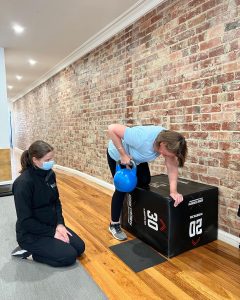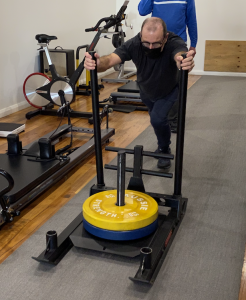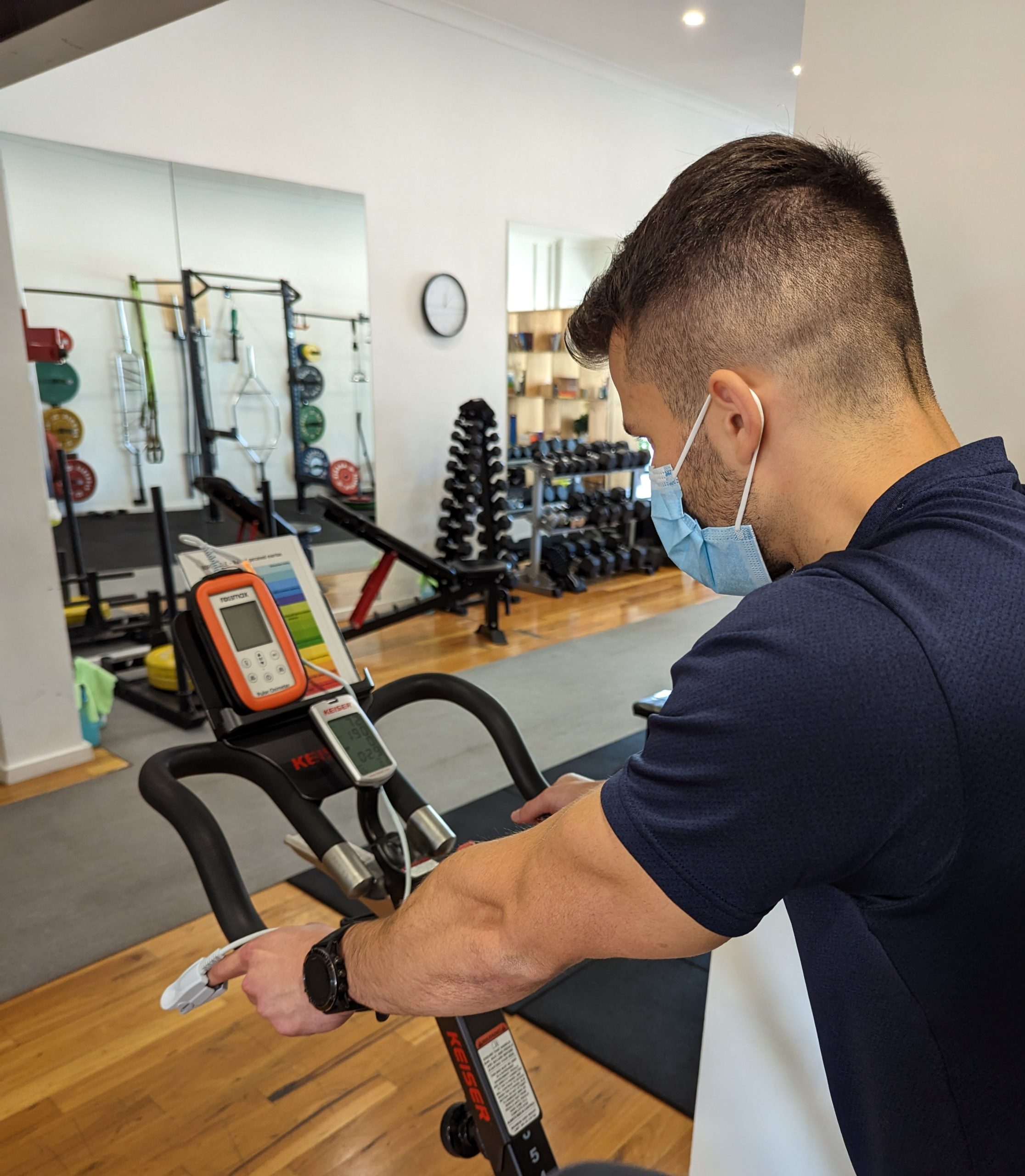What was once a novel coronavirus has become an all too familiar foe, with over 65% (>17 million) of Australians now having been infected with SARS-CoV-2 at least once since the pandemic began [1]. The full repercussions of all these infections remains to be seen, especially with the ever-increasing incidence of what is now being termed the “Post COVID-19 condition”. This condition is defined as the presence of symptoms persisting for at least 2 months in individuals with a history of probable or confirmed SARS-CoV-2 infection [2]. The current estimate for individuals that will go on to develop post COVID-19 condition ranges from 10-30% for non-hospitalized cases and 50-70% for hospitalised cases [3]. This means that there are likely to be millions of Australians experiencing post viral complications and difficulties returning to their normal activities.
Fortunately, if you happen to be struggling with post COVID-19 complications, there are things you can do now which can influence how you recover, and the rate at which you recover. In this article we will discuss:
- How COVID affects your body
- What to expect when returning to exercise and physical activity.
- Benefits of exercise to combat post COVID-19 conditions and associated symptoms.
- Guidelines on when and how to get back to exercise safely.
- Where to go if you need help getting back into exercise
HOW DOES COVID AFFECT YOUR BODY?
SARS-CoV-2 infects your body through its spike protein which latches on to the receptors of healthy cells hijacking its cellular machinery and eventually causing cellular injury and death [4]. It has a particular affinity for certain types of cells found in the lungs and respiratory tract. This is largely why SARS-CoV-2 is known as a respiratory pathogen, however there is increasing evidence of its multi-organ manifestations with reports of tissue damage in the lungs, heart, kidneys, intestine, brain, and muscle [5]

The variance in affected body systems partly explain the large heterogeneity of ongoing symptoms in those with post-COVID-19 condition. One systematic review [6] reported upwards of 60 different physical and physiological signs with wide prevalence. The most common symptoms were weakness (41%), general malaise (33%), fatigue (31%), concentration impairment (26%), breathlessness (25%) and reduced pulmonary function (26%). Other secondary symptoms which persist past 12 weeks included fatigue (8.3%), headache (7.2%), cough (7%) and myalgia (5.6%). Many individuals also experienced a reduction in their quality of life (37%).
A larger and more recent systematic review with a meta-analysis [7] including 735,006 participants, corroborated these findings, reporting fatigue/weakness, disturbed sleep, and breathlessness as the most common symptoms with a high prevalence across hospitalised and non-hospitalised cohorts. Their analysis also revealed that 45% of COVID-19 survivors go on to experience at least one unresolved symptom which is still present by the average follow-up time of 126 days, highlighting the need to address these conditions with adequate therapeutic interventions.
Unfortunately, it is not always clear why these symptoms persist, there are proposed mechanisms implicating an overproduction of proinflammatory cytokines and an increase in oxidative stress damaging organs and causing dysfunction [4]. However, there is evidence indicating that most symptomatic individuals may have functional deficits without organ damage [8, 9].
HOW DOES COVID AFFECT YOUR ABILITY TO FUNCTION AND ENGAGE IN PHYSICAL ACTIVITY?
One study found that those with no clear cause to account for symptoms were seen to have a relatively lower peak volume of oxygen consumption (VO2peak) compared to asymptomatic individuals [9]. VO2Peak is a measure of your cardiorespiratory fitness (CRF) quantifying how well your body uses, delivers oxygen and is largely determined by the function of your lungs, heart, and peripheral musculature.

There is a certain degree of CRF we require just to be able to perform our daily tasks. Having a lower CRF means that you are likely to fatigue quicker when doing activities, your breathing rate will increase sooner, your heart rate will have to shoot up higher than normal for any given task and your perception of effort for each task will be higher.
Another functional deficit almost always detected in individuals post SARS-CoV-2 infection is decreased strength due to the deleterious effects on the neuromuscular system [10]. SARS-CoV-2 infection causes skeletal muscle involution and myocyte damage due to the associated increase in inflammatory pathways and oxidative stress [10]. Effects can be detected even in asymptomatic individuals with strength loss of as much as 30% in 2 weeks [11]. This is further accelerated with the associated immobilisation in bed ridden individuals, demonstrating a 12.5% loss of muscle strength after just 10 days [12].
This decrease in muscle strength can lead to significant disability and can have a significant impact on your ability to perform activities of daily living. You may find that things which were part of your normal routine prior such as carrying shopping, climbing stairs, or lifting weights in the gym, feel significantly harder, forcing you to do less of that task at a given time.
Other non-physical capacities often impacted in those with post-COVID-19 complications include attention, motivation, and mood which are hypothesized to be a result of persistent neuroinflammation, resulting in neurocognitive and psychological dysfunction [13]. These can often be more disruptive than physical deficits and may decrease your ability to adhere to exercise regimens and recommence physical activity, potentially leading to further declines in function.
BENEFITS AND THERAPEUTIC EFFECT OF EXERCISE TO COMBAT THE POST COVID-19 CONDITION.
Although COVID can be associated with various disruptive symptoms and functional impairments, there is promising evidence highlighting role of exercise in addressing many of these aspects.
Exercise is preventative
Before we discuss exercise for recovery after COVID-19, it is briefly worth mentioning the preventative utility of exercise on SARS-CoV2 infection and the resultant severity. Exercise, particularly regular moderate intensity exercise, has a significant impact on the immune system, reducing the frequency and severity of infectious processes, especially respiratory [12]. Exercise enhances our immune system by increasing our natural killer cells (protective immune cells) and activates interferons and other anti-oxidative pathways which reduce viral replication and destroy viral structure, helping to reduce the exacerbated inflammatory state created by SARS-CoV2 [14].
mentioning the preventative utility of exercise on SARS-CoV2 infection and the resultant severity. Exercise, particularly regular moderate intensity exercise, has a significant impact on the immune system, reducing the frequency and severity of infectious processes, especially respiratory [12]. Exercise enhances our immune system by increasing our natural killer cells (protective immune cells) and activates interferons and other anti-oxidative pathways which reduce viral replication and destroy viral structure, helping to reduce the exacerbated inflammatory state created by SARS-CoV2 [14].
Your health status prior to infection matters too, as the consequences of COVID-19 are more severe in those with pre-existing health conditions such as high blood glucose, hypertension, obesity and dyslipidaemia, all of which can be ameliorated to a substantial degree through regular exercise [15].
Exercise is restorative
There is yet to be more research on the benefits of exercise addressing the vast degree of symptoms and conditions present in covid-19 survivors specifically, however there is already good evidence pertaining to the positive effects of exercise on multiple impairments associated with post-COVID-19 condition such as sleep quality, chronic pain/myalgia, depression and anxiety. [16-19]
There is good evidence demonstrating the potential for exercise to mitigate some of the cognitive deficits seen in post COVID-19 such as brain fog. In fact, just a single bout of exercise can improve cognitive and executive function, with regular exercise reducing the risk of developing cognitive impairment [20]. For headaches and migraines, the evidence is weaker, though exercise has been consistently shown to have a significant effect on symptom severity and duration [21].
Exercise evidence in post COVID-19 survivors
Recent evidence evaluating the effect of exercise in COVID-19 survivors specifically have found promising results. A recent meta-analysis [22] investigating the effect of exercise rehabilitation on fatigue included recently hospitalised (~ LOS 15.6 days) participants with COVID-19 related fatigue and found that after the exercise intervention 83% no longer had persistent fatigue and the 17% that did, had a significant reduction in the severity of their fatigue.
Breathlessness, another highly prevalent post COVID-19 symptom, seems to be effectively prevented or reduced through effective exercise rehabilitation, particularly with moderate intensity aerobic exercise [23]. It is important to note that these effects are not just dependant on time and are indicative of the therapeutic utility of exercise itself as breathlessness is seen to remain unresolved for 1 in 5 survivors after acute illness [23].
Are there certain types of exercise which are favourable?
Evidence related to the specifics of exercise for post COVID-19 recovery is still in its infancy, however a recent review including 433 participants across 9 studies investigated the effect of therapeutic exercise interventions on restoring muscle strength, respiratory function, physical capacity and quality of life [12].  The exercise interventions were effective at improving all of these variables with no reported adverse events in any study. The interventions included aerobic exercise, anaerobic exercise, strength training, ventilatory pattern re-education and respiratory muscle training or a combination of these [12].
The exercise interventions were effective at improving all of these variables with no reported adverse events in any study. The interventions included aerobic exercise, anaerobic exercise, strength training, ventilatory pattern re-education and respiratory muscle training or a combination of these [12].
The researchers also identified two important aspects of effective recovery:
- Early mobilisation (such as those described in the early phase of acute recovery. These can minimise decline in physical health related to prolonged bed rest and being sedentary as well as mitigate declines in mental health caused by illness, quarantine, and stressors.
- Individualised training (resistance training is initially tolerated better earlier, followed by the introduction of aerobic exercise at a low intensity)
Should any types of exercise be avoided?
There is a question around whether high intensity exercise should be avoided or considered in your road to recovery from covid-19. On one hand there is evidence that high intensity exercise can reduce immune protection and increase inflammation acutely [24], suggesting it would not be appropriate, especially in the early stages of recovery. Interestingly however, there is conflicting evidence in a small randomised-controlled trial (RCT) which shows that high intensity interval training (HIIT) is beneficial and safely tolerated in patients previously hospitalised with severe COVID-19 (average of 40 days after hospitalisation) [25]. There is currently another RCT yet to be released, directly comparing HIIT and moderate intensity continuous training in COVID-19 survivors, which may shed some more light on this question [26].
WHEN AND HOW TO GET BACK TO EXERCISE SAFELY.
Recently Exercise and Sport Science Australia have released guidelines for clinicians in guiding people at different stages of COVID-19 infection through exercise. We will provide a brief summary of the key considerations in this article, however if you wish to read the full document you can click here.
When returning to exercise it is important to note that you must not commence exercise any earlier than 7 days post infection.
Based on the guidelines; individuals should not commence exercise until they have been free of acute symptoms (no persistent fever, breathlessness at rest, chest pain, palpitations, or any other contraindications to exercise), and are able to complete activities of daily living within tolerable symptom limits.
For asymptomatic individuals exercise can commence 7 days after positive RAT/PCR. Thereafter exercise can be gradually introduced starting with low intensity.

If you have any persistent difficulties e.g., heart, lungs, neurological, gastrointestinal, psychological etc. it is advised that you have further assessments relevant to the symptoms you’re experiencing. This can be as simple as having a chat with your GP or health professional who can refer you for further examinations. If you have gone for further examination for any abnormal or persistent symptoms, it is suggested you undergo supervised exercise with an exercise professional to ensure adequate graded return to exercise and monitor for exacerbations in your symptoms.
The phased approach
In general, returning to exercises consists of 5 phases which begin with preparation for exercise progresses every 3 days within symptom limits and dependent on recovery from the exercise bout.
Phase 1 Preparation: breathing exercises, flexibility/stretching, balance and gentle walking (RPE 0-1/10).
Phase 2 Low intensity: low intensity activity including light yoga, light household tasks, walking (RPE 1-2/10).
Phase 3 Moderate Intensity: aerobic and strength-based exercise, intersperse activity with rest periods (e.g. 5 min active followed by a 1 minute rest and repeat) (RPE 3-4/10).
Phase 4 Moderate Intensity: aerobic and strength-based exercise with coordination skills, 2-day training with 1 day recovery (RPE 3-4/10).
Phase 5 Baseline Exercise: Return to regular pattern or goal exercise pattern (RPE = as tolerated)
These stages are gradual, with small increases in time or intensity per day. If at any stage your symptoms are getting worse regress back to the previous stage.
For instance, if you started to jog continuously for 15 minutes and feel worse go back to the previous stage where you may jog for 5 and rest for 1 minute 3 times.
There is no set standard for the time course of your recovery as individuals vary significantly in their presentation. For instance, there are certain associated conditions (although rare) which have a completely different time-course for recovery as in the case of acute myocarditis where moderate intensity can be introduced after 1 month but should generally not be increased before 3 months [5].
When to stop exercise?
Any level or type of exercise that exacerbates your symptoms during this whole-time course should be avoided and there are contraindications to look out for during exercise indicating the need for a medical review before continuing exercise:
During Exercise
- Body aches or pains without known reason for onset
- Signs and symptoms of fever
- New onset of breathlessness at rest
- Chest tightness, pain or discomfort, or signs symptoms of unstable angina
- Dizziness, light-headedness, presyncope, palpitations, arrhythmia
- Features of thrombosis (limb swelling/warmth/discolouration, increased breathing rate, low oxygen saturation levels, coughing up blood)
- Loss of balance
- New onset confusion/delirium or focal neurological signs and symptoms
Post Exercise
- Fever
- Fatigue and post exertional malaise
- Breathlessness
- Chest pain
- Muscle joint aches/pains
WHERE TO GO IF YOU NEED HELP GETTING BACK INTO EXERCISE
With all the debilitating symptoms associated with COVID-19, it’s reasonable to have concerns about recommencing exercise. If you are unsure how to go about your return to physical activity and need further guidance, an Accredited Exercise Physiologist can help you through this process and ensure you progress towards your goals safely.
Written by: Chris Kardaras AEP, AES
References
- Lifeblood, A.R.C. and Hirani, R., 2022. Seroprevalence of SARS-CoV-2-specific antibodies among Australian blood donors: Round 3 update.
- World Health Organization, 2021. A clinical case definition of post COVID-19 condition by a Delphi consensus, 6 October 2021(No. WHO/2019-nCoV/Post_COVID-19_condition/Clinical_case_definition/2021.1). World Health Organization.
- Davis, H.E., McCorkell, L., Vogel, J.M. and Topol, E.J., 2023. Long COVID: major findings, mechanisms and recommendations. Nature Reviews Microbiology, pp.1-14.
- Bohn, M.K., Hall, A., Sepiashvili, L., Jung, B., Steele, S. and Adeli, K., 2020. Pathophysiology of COVID-19: mechanisms underlying disease severity and progression. Physiology, 35(5), pp.288-301.
- Cattadori, G., Di Marco, S., Baravelli, M., Picozzi, A. and Ambrosio, G., 2022. Exercise training in post-COVID-19 patients: the need for a multifactorial protocol for a multifactorial pathophysiology. Journal of Clinical Medicine, 11(8), p.2228.
- Michelen, M., Manoharan, L., Elkheir, N., Cheng, V., Dagens, A., Hastie, C., O’Hara, M., Suett, J., Dahmash, D., Bugaeva, P. and Rigby, I., 2021. Characterising long COVID: a living systematic review. BMJ global health, 6(9), p.e005427.
- O’Mahoney, L.L., Routen, A., Gillies, C., Ekezie, W., Welford, A., Zhang, A., Karamchandani, U., Simms-Williams, N., Cassambai, S., Ardavani, A. and Wilkinson, T.J., 2023. The prevalence and long-term health effects of Long Covid among hospitalised and non-hospitalised populations: A systematic review and meta-analysis. EClinicalMedicine, 55, p.101762.
- Kersten, J., Baumhardt, M., Hartveg, P., Hoyo, L., Hüll, E., Imhof, A., Kropf-Sanchen, C., Nita, N., Mörike, J., Rattka, M. and Andreß, S., 2021. Long COVID: distinction between organ damage and deconditioning. Journal of Clinical Medicine, 10(17), p.3782.
- Brown, J.T., Saigal, A., Karia, N., Patel, R.K., Razvi, Y., Constantinou, N., Steeden, J.A., Mandal, S., Kotecha, T., Fontana, M. and Goldring, J., 2022. Ongoing Exercise Intolerance Following COVID‐19: A Magnetic Resonance–Augmented Cardiopulmonary Exercise Test Study. Journal of the American Heart Association, 11(9), p.e024207.
- Levy, D., Giannini, M., Oulehri, W., Riou, M., Marcot, C., Pizzimenti, M., Debrut, L., Charloux, A., Geny, B. and Meyer, A., 2022. Long term follow-up of sarcopenia and malnutrition after hospitalization for COVID-19 in conventional or intensive care units. Nutrients, 14(4), p.912
- Trinity, J.D.; Craig, J.C.; Fermoyle, C.C.; McKenzie, A.I.; Lewis, M.T.; Park, S.H.; Rondina, M.T.; Richardson, R.S. Impact of presymptomatic COVID-19 on vascular and skeletal muscle function: A case study. Appl. Physiol.2021, 130, 1961–1970
- Fernández-Lázaro, D., Santamaría, G., Sánchez-Serrano, N., Lantarón Caeiro, E. and Seco-Calvo, J., 2022. Efficacy of Therapeutic Exercise in Reversing Decreased Strength, Impaired Respiratory Function, Decreased Physical Fitness, and Decreased Quality of Life Caused by the Post-COVID-19 Syndrome. Viruses, 14(12), p.2797.
- Castanares-Zapatero, D., Chalon, P., Kohn, L., Dauvrin, M., Detollenaere, J., Maertens de Noordhout, C., Primus-de Jong, C., Cleemput, I. and Van den Heede, K., 2022. Pathophysiology and mechanism of long COVID: a comprehensive review. Annals of Medicine, 54(1), pp.1473-1487.
- Fernández-Lázaro, D., González-Bernal, J.J., Sánchez-Serrano, N., Navascués, L.J., Ascaso-del-Río, A. and Mielgo-Ayuso, J., 2020. Physical exercise as a multimodal tool for COVID-19: could it be used as a preventive strategy?. International journal of environmental research and public health, 17(22), p.8496.
- Callender, L.A., Curran, M., Bates, S.M., Mairesse, M., Weigandt, J. and Betts, C.J., 2020. The impact of pre-existing comorbidities and therapeutic interventions on COVID-19. Frontiers in immunology, 11, p.1991.
- Xie, Y., Liu, S., Chen, X.J., Yu, H.H., Yang, Y. and Wang, W., 2021. Effects of exercise on sleep quality and insomnia in adults: a systematic review and meta-analysis of randomized controlled trials. Frontiers in psychiatry, 12, p.664499.
- Geneen, L.J., Moore, R.A., Clarke, C., Martin, D., Colvin, L.A. and Smith, B.H., 2017. Physical activity and exercise for chronic pain in adults: an overview of Cochrane Reviews. Cochrane Database of Systematic Reviews, (4).
- Kvam, S., Kleppe, C.L., Nordhus, I.H. and Hovland, A., 2016. Exercise as a treatment for depression: a meta-analysis. Journal of affective disorders, 202, pp.67-86.
- Aylett, E., Small, N. and Bower, P., 2018. Exercise in the treatment of clinical anxiety in general practice–a systematic review and meta-analysis. BMC health services research, 18, pp.1-18.
- Northey, J.M., Cherbuin, N., Pumpa, K.L., Smee, D.J. and Rattray, B., 2018. Exercise interventions for cognitive function in adults older than 50: a systematic review with meta-analysis. British journal of sports medicine, 52(3), pp.154-160.
- Varangot-Reille, C., Suso-Martí, L., Romero-Palau, M., Suárez-Pastor, P. and Cuenca-Martínez, F., 2022. Effects of different therapeutic exercise modalities on migraine or tension-type headache: a systematic review and meta-analysis with a replicability analysis. The Journal of Pain, 23(7), pp.1099-1122.
- de Sire, A., Moggio, L., Marotta, N., Agostini, F., Tasselli, A., Drago Ferrante, V., Curci, C., Calafiore, D., Ferraro, F., Bernetti, A. and Ozyemisci Taskiran, O., 2022. Impact of rehabilitation on fatigue in post-COVID-19 patients: a systematic review and meta-analysis. Applied Sciences, 12(17), p.8593.
- Zheng, B., Daines, L., Han, Q., Hurst, J.R., Pfeffer, P., Shankar-Hari, M., Elneima, O., Walker, S., Brown, J.S., Siddiqui, S. and Quint, J.K., 2022. Prevalence, risk factors and treatments for post-COVID-19 breathlessness: a systematic review and meta-analysis. European Respiratory Review, 31(166).
- Simpson, R.J., Kunz, H., Agha, N. and Graff, R., 2015. Exercise and the regulation of immune functions. Progress in molecular biology and translational science, 135, pp.355-380.
- Foged, F., Rasmussen, I.E., Budde, J.B., Rasmussen, R.S., Rasmussen, V., Lyngbæk, M., Jønck, S., Krogh-Madsen, R., Lindegaard, B., Ried-Larsen, M. and Berg, R.M.G., 2021. Fidelity, tolerability and safety of acute high-intensity interval training after hospitalisation for COVID-19: a randomised cross-over trial. BMJ Open Sport & Exercise Medicine, 7(3), p.e001156.
- Gomes, V., Fontoura, F., Saquetto, M.B., Ramos, T., Santos, S., Suzart, W., Rivas, P., Martinez, B.P., Barreto, A.P., Lima, M. and Gomes, M.N., 2023. Comparison of High-Intensity Interval Training to Moderate-Intensity Continuous Training for Functioning and Quality of Life in Survivors of COVID-19 (COVIDEX): Protocol for a Randomized Controlled Trial. Physical Therapy, p.pzad028.
- Seo, D.Y., Heo, J.W., Ko, J.R. and Kwak, H.B., 2019. Exercise and neuroinflammation in health and disease. International neurourology journal, 23(Suppl 2), p.S82.
- . Kelley GA and Kelley KS. Exercise and sleep: a systematic review of previous meta-analyses. J Evid Based Med 2017; 10(1): 26-36.
- Geneen, L.J., Moore, R.A., Clarke, C., Martin, D., Colvin, L.A. and Smith, B.H., 2017. Physical activity and exercise for chronic pain in adults: an overview of Cochrane Reviews. Cochrane Database of Systematic Reviews, (4).

